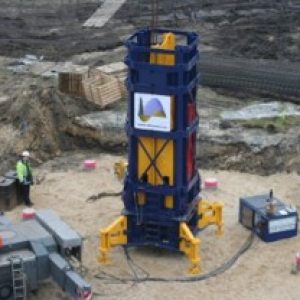Rapid Load Testing
Rapid Load Testing
A powerful quasi static test method for determining the static load capacity of piles in compliance with ASTM D7383 and EuroCode 22477-10
Key Characteristics
- Fast method for pile load testing
- Test method that embodies the advantages of Static Load Testing (SLT) and Dynamic Load Testing (DLT) and eliminates the disadvantages of these
- Direct measurement of force and displacements
- Load-settlement diagram as direct output without a stress wave analysis (no signal matching)
- Test execution user independent
- High accuracy, reliability and reproducible
- Fully compliant with international standards (ASTM, EuroCode, etc)
StatRapid is one of the methods of Rapid Load Testing

Rapid Load Testing is a method were a pile is loaded in a short moment, giving a gentle push on the pile top. This method is much faster than static load testing. The duration of the load is much longer than during a Dynamic Load Test or PDA. Due to the long duration of the load, no stress waves phenomena are involved. When the requirements of the quasi static situation are fulfilled, the interpretation of the Rapid Load Test results are straightforward, without stress wave analysis and without Signal Matching. As a result, the results of Rapid Load Tests are more accurate, reliable, and man-independent.
Rapid Load Testing has two major test methods: StatNamic and StatRapid.
StatRapid
StatRapid is the quasi static, high strain test method for determination of the bearing capacity of foundation piles. Within the StatRapid test method a drop weight is dropped on a special designed StatRapid cushioning. Due to its special characteristics, the kinetic energy of the drop weight is transferred in a relative long duration push on top of the pile. StatRapid is based on the Rapid Load Testing method, and therefor combines all benefits from Static and Dynamic Testing: A StatRapid Load Test requires limited time, lower costs and yields high accuracy results.
StatNamic
StatNamic has been developed in the 80’s of last century, and was the first test method for Rapid Load Testing. The method is based on launching a mass from the pile top. Using the Newton law’s, for Force = Mass * Acceleration and Action=Reaction, the StatNamic test device gave a gentle, short push on top of the pile. Long enough to avoid stress wave phenomena.
THE STATRAPID TEST DEVICE
The StatRapid device is available with weights of 40 and 80 tonnes and more. Leading to testing load up to 12 and 20 MN and more, depending on the soil and pile conditions.
Each device consists of a basic frame including load cells, the special for Rapid Load Testing designed cushioning, which is modular both in number of spring elements as in stiffness of each spring element. The upper frame includes the hydraulics for lifting and catching and the test weight. The test weight is also modular. Weight can be added or removed in order to optimise the setup for each pile, depending on soil conditions and on the required test load.
Relationship between drop heigth and test load will be determined prior to the tests, using AllWave-RLT. This program, as part of the AllWave Software Package, simnulates the Rapid Load Tests, incorporating all possible influences from pile, soil and testing setup.
MONITORING SENSORS
The monitoring system of the any Rapid Load Testing, i.e. StatRapid or StatNamic, consists of the PDR data acquisition unit and various sensors recording the following quantities at the pile top:
- The load, measured with one or more load cells
- The displacements with the Allnamics Reyca optical system with reflector on the pile
- The accelerations with a sensitive accelerometer
Direct measurements of loads and settlements gives direct measured load-settlement diagrams. By analysing the results with the Unloading Point Method, according to ASTM and EuroCodes (and other codes), the static load diagram is obtained.
SPECIFICATIONS AND CODES
The tests of the Rapid Load Testing are in compliance with a.o. ASTM D7383, and EuroCode EN ISO-22477-10, as well as other national codes (i.e. Dutch CUR-230). According to these codes:
- Test data analysis based on user-independent principles,
- No signal matching is required: direct load-settlement diagram as output
- Taking into account loading rate dependencies of the soil (as for DLT and PDA)
ADVANTAGES
- Test data analysis based on user-independent principles,
- No signal matching is required.
- Taking into account loading rate dependencies of the soil (as for DLT and PDA)
RAPID LOAD TESTING ON YOUTUBE
- Pile Load Testing at Hamburg, Germany
- Rapid Load Testing for wind farms
- StatRapid 16 MN Tests
- Rapid Load Testing, DownTown at The Hague, The Netherlands
- StatRapid tests (playlist)
- StatNamic tests (playlist)
- Biggest StatNamic Pile Test in the world: 107 MN
See also our YouTube Allnamics channel and YouKu Allnamics channel



